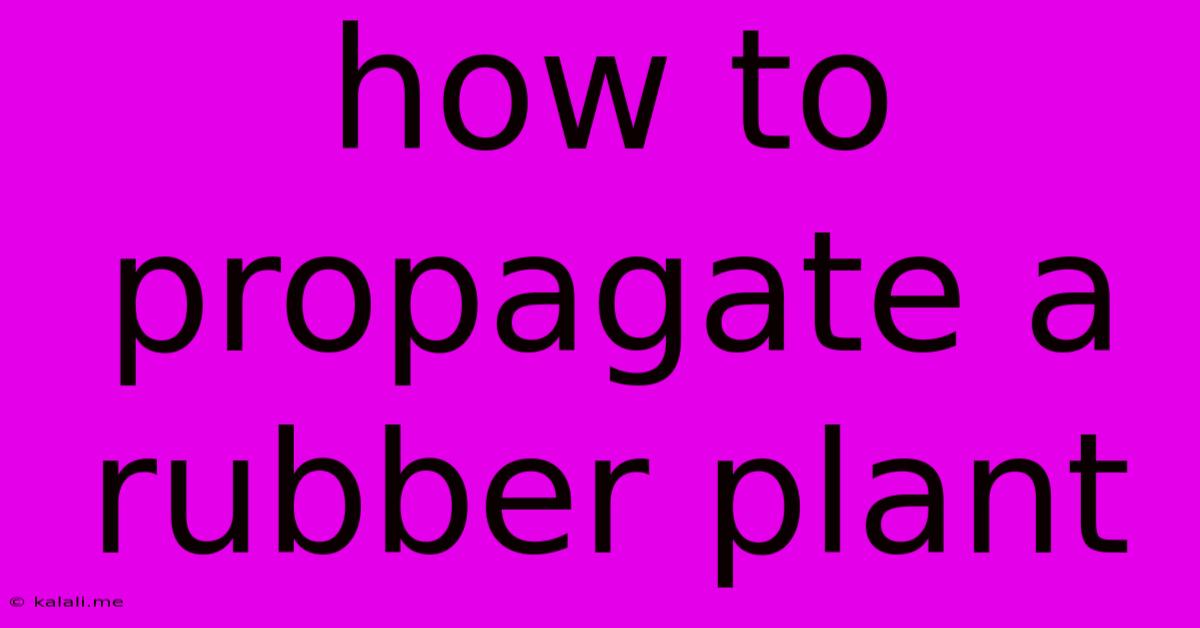How To Propagate A Rubber Plant
Kalali
Jun 08, 2025 · 3 min read

Table of Contents
How to Propagate a Rubber Plant: A Comprehensive Guide
Rubber plants ( Ficus elastica) are beloved for their large, glossy leaves and relatively easy care. But what if you want to expand your rubber plant collection without breaking the bank? The good news is that propagating a rubber plant is surprisingly straightforward. This guide will walk you through several effective methods, helping you successfully grow new plants from cuttings. Whether you're a seasoned plant parent or a beginner, this comprehensive guide will equip you with the knowledge to successfully propagate your rubber plant.
Choosing the Right Cutting
The key to successful propagation lies in selecting a healthy cutting. Look for a stem that is:
- Mature but not woody: Avoid overly young, succulent stems, as well as extremely old, woody ones. A stem with a slightly firm texture is ideal.
- Disease-free: Inspect the stem for any signs of pests, diseases, or damage. A healthy cutting is crucial for successful rooting.
- At least 4-6 inches long: Longer cuttings generally have a better chance of success. Aim for a cutting with several leaves.
Method 1: Water Propagation
Water propagation is a popular and simple method for propagating rubber plants. Here's a step-by-step guide:
- Prepare the cutting: Use a sharp, clean knife or pair of pruning shears to make a clean cut just below a node (the point where a leaf or branch emerges from the stem). Remove the lower leaves to prevent rot.
- Place in water: Submerge the cut end of the cutting in a jar or glass filled with clean water. Change the water every 2-3 days to prevent bacterial growth.
- Provide indirect light: Place the jar in a location with bright, indirect light. Avoid direct sunlight, which can scorch the leaves.
- Wait for roots: Root development typically takes several weeks, sometimes longer. Once roots have formed (about 1-2 inches long), you can transplant the cutting into soil.
Method 2: Soil Propagation
Soil propagation offers a more direct route to a rooted plant, bypassing the water propagation stage.
- Prepare the cutting: As with water propagation, make a clean cut just below a node and remove the lower leaves.
- Prepare the potting mix: Use a well-draining potting mix, such as a mix of peat moss, perlite, and vermiculite.
- Plant the cutting: Dip the cut end of the cutting in rooting hormone (optional but helpful) and plant it in the potting mix. Ensure the lower nodes are partially buried.
- Provide warmth and humidity: Cover the pot with a plastic bag or humidity dome to create a humid environment. Place the pot in a warm location with indirect light. Regularly check the moisture level and ventilate the cover to prevent mold.
- Wait for roots: This method may take a little longer than water propagation, but it ultimately leads to a plant directly established in soil.
Aftercare for Your New Rubber Plant
Once your cutting has rooted, whether in water or soil, you'll need to provide proper aftercare to help it thrive:
- Repotting: Once the roots are well-established, repot the plant into a slightly larger pot with fresh potting mix.
- Watering: Water the plant regularly, but avoid overwatering, which can lead to root rot. Let the top inch or two of soil dry out before watering again.
- Light: Provide bright, indirect light. Avoid direct sunlight, especially during the hottest part of the day.
- Fertilizing: Fertilize your plant during the growing season (spring and summer) with a balanced liquid fertilizer.
By following these steps and providing proper care, you'll successfully propagate your rubber plant and enjoy the satisfaction of growing your own beautiful foliage. Remember patience is key, and even with careful attention, some cuttings may take longer to root than others. Don't be discouraged – keep trying, and you'll soon have a thriving collection of rubber plants!
Latest Posts
Latest Posts
-
What Is An Aside In A Play
Jun 09, 2025
-
Can You Take A Bottle Of Wine On A Plane
Jun 09, 2025
-
Orange Discoloration On Macbook Pro Screen
Jun 09, 2025
-
What Does It Mean To Simplify In Math
Jun 09, 2025
-
Can People Who Speak Different Languages Sign To Each Other
Jun 09, 2025
Related Post
Thank you for visiting our website which covers about How To Propagate A Rubber Plant . We hope the information provided has been useful to you. Feel free to contact us if you have any questions or need further assistance. See you next time and don't miss to bookmark.